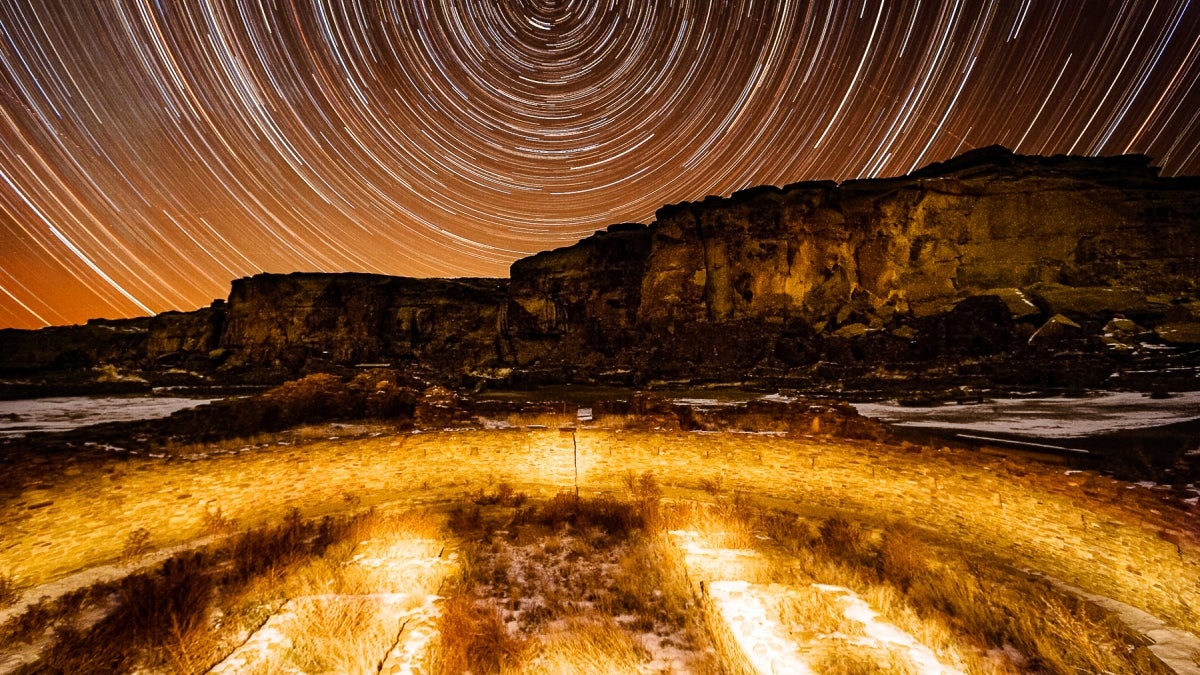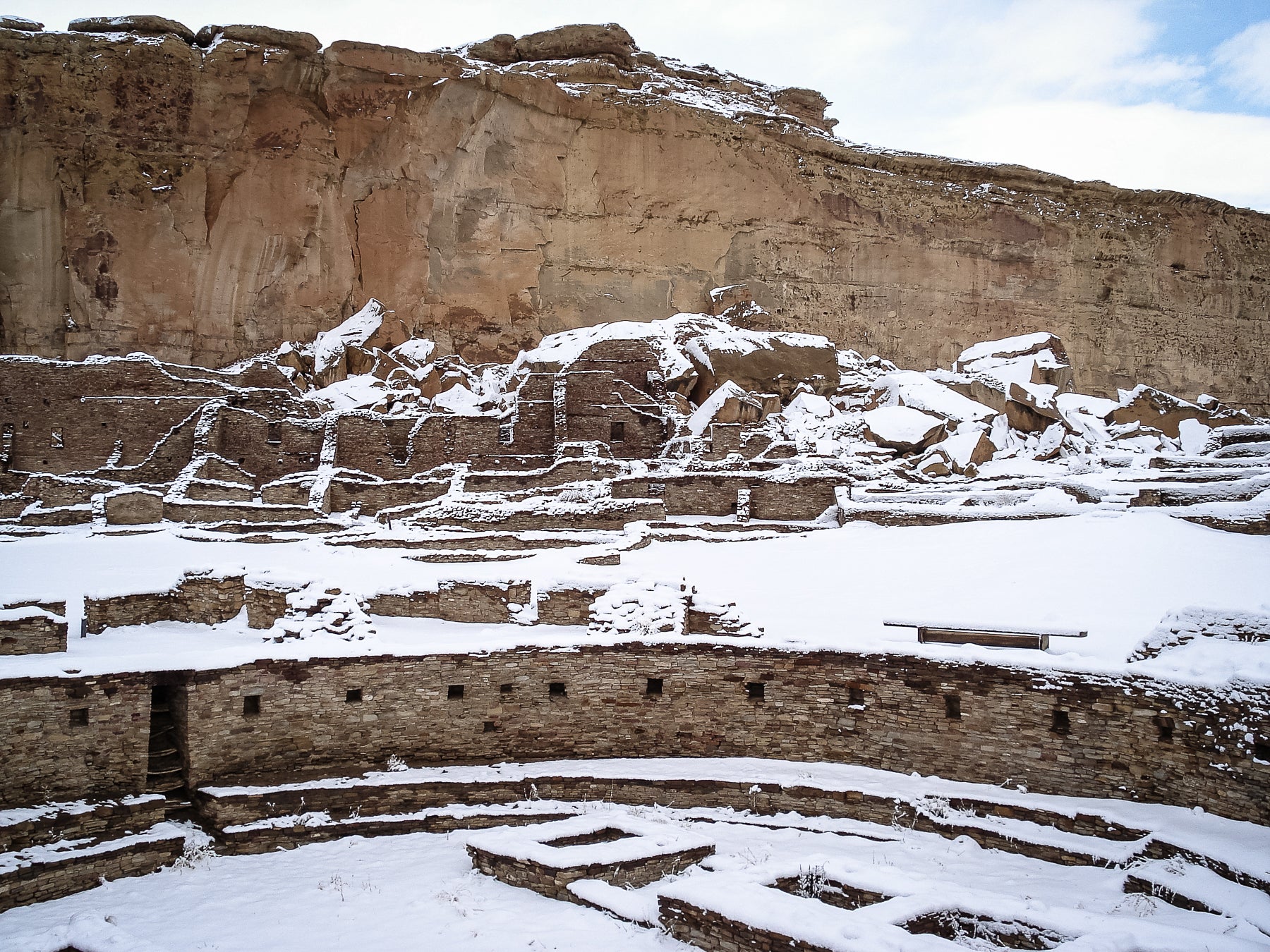In a remote canyon in northwestern New Mexico sits one of America’s greatest historical treasures — and one of the Southwest’s greatest mysteries.
Chaco Canyon was the center of the ancestral Puebloan world, home to immense great houses as high as five stories tall and containing as many as 800 rooms, cavernous kivas built so that dancers appeared to rise out of fires during ceremonies, engineered roads, a prehistoric observatory and systems for communication.
Between A.D. 850 and 1150, Chaco flourished, inspiring imitation in construction and design throughout the region. By about 1150 A.D. the major construction projects stopped and population declined dramatically for centuries. Some of the buildings were the largest structures in North America ever built until the 19th century.
Today it is a sacred ancestral landscape to the Pueblos of New Mexico and Arizona, the Dine’ (Navajo) and many other groups in the Southwest. It is a UNESCO World Heritage Site and a national park.
Pueblo Bonito from cliff. Photo courtesy National Park Service
An Arizona State University archaeologist continues to study the mysteries of Chaco today, as part of a team recently funded by the National Science Foundation for the fourth time.
Matt Peeples, an associate professor of anthropology and the director of the Center for Archaeology and Society in the School of Human Evolution and Social Change has been involved with the Southwest Social Networks Project since 2011.
The project is a collaboration between researchers at a nonprofit called Archaeology Southwest, ASU, the University of Arizona and the University of Colorado at Boulder.
“It involves compiling information published in the past from all over the Southwest,” Peeples said. “Essentially, we're gathering information on the kinds of things people made and used at sites that have Chacoan architecture across the Southwest.”
The project gathers information on ceramics, lithic materials and things like obsidian that can be tracked to specific sources so archaeologists can better understand connections between different areas of the Southwest that all seemed to have connections to Chaco.
“We're starting to get a better understanding of Chaco as a place that had connections to many different parts of the Southwest, but not all at the same time,” Peeples said. “There were shifting patterns of interactions with the broader Colorado Plateau and even beyond, through time. It seems early on, a lot of the connection and influence was to the south and areas down even to the Arizona Mogollon mountains. And later in time, we see connections to the north, toward the area near Mesa Verde National Park.
"With better data, we're starting to be able to parse that out how those connections change through time across decades. So rather than just seeing it as a big smear of influence across an entire region through time, we're seeing the shifting connections and directions of influence over the course of the century-and-a-half that Chaco was at its peak.”
Peeples cautioned there are a lot of different ideas about this, and it’s far from a settled question.
There are strong economic connections between the Chacoan world and Chaco proper. Pottery comes in from different areas, but doesn’t leave Chaco in the same way. Trees for construction come from the Zuni Mountains to the south, the Chuska Mountains to the west and the San Juan Mountains to the north.
People engaged in different ways in their connection with Chaco.
There’s evidence of ritual and religious connections from Chaco to outlying sites, as well as similar architecture. Design styles also spread out from the great city. Recently, Peeples and his colleagues explored Dogoszhi style pottery, characterized by beautiful hash marks in designs. It’s long been seen as a hallmark of Chacoan influence in various parts of the Southwest.
“Through time, what we saw is that the distribution of those designs is actually more restricted than the distribution of Chacoan architecture. So that suggests that different aspects of Chacoan culture were adopted — or not — by people at various scales. So it doesn't seem like there's a one-size-fits-all answer for what Chaco meant across the Southwest.”
People constructing buildings or painting pottery in the style of Chaco might have been saying, “We’re like Chaco over here,” or “This is how it’s done in Chaco.”
There are Chaco-style structures all over the Southwest, some with strong ties to the city. At Aztec National Monument, layouts mirror those at Chaco. There is evidence that materials moved back and forth between the two places.
“Aztec seems to be a place that takes the mantle of Chaco in a little bit of a later era,” Peeples said.
In other places, the construction is Chaco-inspired, but there is little other evidence connecting the site to the city.
“So it may have been using the symbolism of Chaco and architecture for local ends rather than because of a direct connection to this distant place,” he said.
One question that has hung over the canyon is how many people lived there. Did the population swell during ceremonial periods? How many people lived in the immense great houses?
Pueblo Bonito in snow. Courtesy of the National Park Service
Pueblo Bonito, the biggest great house in the Southwest, had about 800 rooms. It wasn’t built all at once; as it was added on to, the deep rooms were used for storage and special uses. (One room was dedicated to red macaw parrots.) Archaeologists have counted the number of cooking hearths or compared them to contemporary room clusters in places like Hopi today. It suggests many of the great houses had relatively small resident populations.
“What we see is south of Chaco Wash on the south side of Chaco Canyon, there's a really large population of people living in what we call the small houses, essentially houses that are more typical of the rest of the Southwest,” Peeples said. “So there was a large resident population in the general Chaco Canyon area. But the great houses, you know, just because it's a 700-room pueblo doesn't mean it had a thousand people in it.”
What the Southwest Social Networks Project is compiling is information from published reports and notes — some of it a century old — and answering old questions with new data that brings up a host of other new questions.
“In our current grant, we've built a platform called CyberSW.org, which is a tool that helps other researchers and other interested people get access to these data,” Peeples said. “Our current National Science Foundation grant is working to see what we might be able to do at a smaller scale and to investigate patterns of interaction within individual villages and among households using similar methods.”
Top image: Pueblo Bonito Kiva at night with star paths. Courtesy of Chaco Culture National Historical Park, National Park Service, Department of the Interior
More Arts, humanities and education

ASU workshop trains educators, professionals from marginalized communities in disaster science
As devastating as hurricanes can be to anyone caught in their paths, they strike marginalized communities even harder.To address this issue, a fund named for a former Arizona State University…

ASU’s Humanities Institute announces 2024 book award winner
Arizona State University’s Humanities Institute (HI) has announced “The Long Land War: The Global Struggle for Occupancy Rights” (Yale University Press, 2022) by Jo Guldi as the 2024…

Retired admiral who spent decades in public service pursuing a degree in social work at ASU
Editor’s note: This story is part of coverage of ASU’s annual Salute to Service.Cari Thomas wore the uniform of the U.S. Coast Guard for 36 years, protecting and saving lives, serving on ships and…


